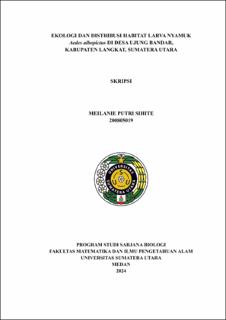| dc.description.abstract | Dengue hemorrhagic fever (DHF) is caused by the dengue virus which is transmitted through the bite of female Aedes aegypti and Aedes albopictus mosquitoes. Controlling the transmission of the disease can be done through surveillance activities such as monitoring mosquito larval habitats, which is very important to do as an early detection of the spread of DHF. This study was conducted to determine the larval habitat, abiotic and biotic factors in Dusun V (Deleng Payung), Ujung Bandar Village, Langkat Regency, North Sumatra, using the accidental sampling method with a distance of up to 2 km2 from residential areas. Mosquito larvae found were collected and morphologically identified using a key book with pictures of adult Aedes mosquitoes in Indonesia and pictures of Aedes larvae in Indonesia (Ministry of Health, 2013) and Olympus Stereo Microscope. The results of this study showed that the Aedes spp. larvae found were Ae. albopictus. In this study, 33 Ae. albopictus larval habitats were found in three types of land use, namely, residential areas (86%), polyculture plantations (46%), and oil palm plantations (33%) out of a total of 90 habitats surveyed. The abiotic factors that dominate are metal-based brooding sites (100%), perimeter <0.5 meters (60%), shallow depth of 10-30 cm (82%), clean water conditions (60%) and non-flowing water conditions (50%). There was no significant difference between Aedes larvae positive habitat and Aedes larvae negative habitat in temperature, pH, and salinity. Biotic factors that dominated were no vegetation (55%), no canopy (55%), and no aquatic predators (54%). The density index value of Ae. albopictus larvae in residential areas in 70 houses, namely, high-risk House Index (HI) (8.57), high-risk Container Index (CI) (85.71), low-risk Breateau Index (BI) (8.57), and ABJ (91%) which indicates that Hamlet V (Deleng Payung) has a high risk of dengue transmission. North Sumatra | en_US |


